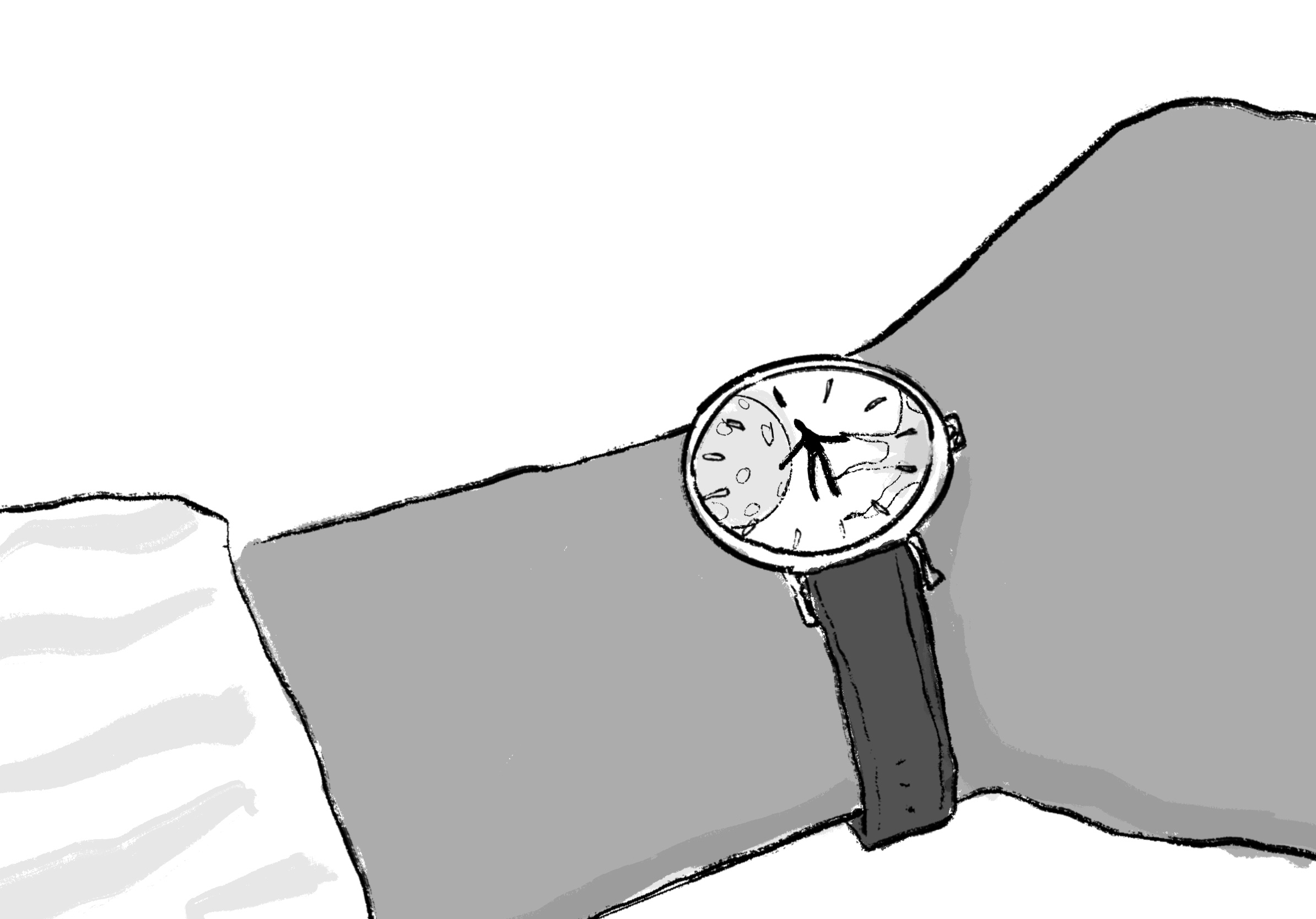Open Edges: What time is it?
February 3, 2023
 Kyra Tan
Kyra Tan“We are not points on a line; rather, we are the centers of circles.” – John Berger
Sometimes I wear a watch, but never to tell the time. Last summer, every day that I was in Mt. Shasta, Calif., doing EMT training, I fastened a cheap digital Armitron to my left wrist with a soft, black plastic strap, in which I bored an extra hole between the third and fourth ones—I hadn’t noticed the irregular size and shape of my wrists before. My artistic acumen and prowess with a baby screwdriver seemed to cure what ailed, though. The watch was snug and not uncomfortable to wear all day, and at night when the latch unclasped, I didn’t really mind the red curvilinear indents in my flesh where the band had started to dig in. They were always gone by morning.
With days as long as nights, nights as warm as days and classmates who knew better than I when we should be where, telling time ceased to matter. If I found myself lost, I had only to look around … their absence was usually more telling than their presence. What, then, did I use my watch for? Part of our training regimen was to learn to take vitals accurately and efficiently, and for that we needed no more than seconds. Thirty or less for each vital sign, to be exact. (O.K., I’m not being exactly exact. There’s no way I can use a sphygmomanometer in thirty seconds or less—can you even spell sphygmomanometer in under half a minute?) Heart and respiratory rate clock in at thirty seconds, and the digitized display made it easy to keep track by counting.
See? No time-telling for me! Counting with my own personal visual metronome, of sorts, is all I did, since it’s almost impossible to count the beats of two different rhythms simultaneously. The solution is to cooperate, to divide and conquer, with one rhythm entrusted to the watch face and the other to the tips of any two fingers (but never the thumb) or two ears, maybe aided by a stethoscope. Vision, audition and tactile perception, along with objects that mediate these interactions, build intersubjective relationships that are part and parcel of the process of counting, a feature of time-keeping distinct from the more disengaged practice of telling, or being told, the time. Thus, I did not tell time—I kept it, saw it move, heard it thud, felt it thump—with the help of a few objects, or not.
The distinction between time-telling and time-keeping in the overarching realm of time-reckoning is significant but nebulous. Simply put, the former is more akin to rote memorization, whereas the latter is like critical thinking. Both are necessary for the practice of story-telling, which is what time-reckoning is in general. Ultimately, these delineations are not meant to categorize; rather, they reopen the concept of time for further exploration. Temporality—the fabric of our experience in and relationship with time—is rhythmic, cyclical, experienced sensorially: it is a site for interaction, meaning-making, and world-building.
As we know it, the empty, homogenous time of modernity (… to industrialism and beyond!) unfolds in standardized units. This conceptual framework of temporality, mapped out by Walter Benjamin, is nonlinear and imbued with rhetoric propagating notions of progress and causality. For example, we cast our aspirations for change in the future—since when? We structure our lives around the units of work hours, days and weeks that fit into the Gregorian calendar—how else would we? Our sense of time is most often defined by our ability to read clocks and calendars—well, so what? Simply put, time-telling, only a single patch in the sprawling quilt of temporal experience, has become mistaken for the whole.
It is difficult to imagine an alternative framework for thinking about temporality, but we can start with the same tools we already use: clocks and calendars, the two most common time-telling objects. How they tell time is not common knowledge, however. Most might imagine that the modern clock tells time based upon some sort of astronomical cues or the earth’s rotation. In reality, all of our digital clocks are linked to cycles of cesium atom decay. On one hand, this example illustrates that time as we know it has become an abstract quantity unfamiliar to our lived experience, but it also illuminates a few threads of the histories, practices and choices running through the knot of modern time-reckoning.
Clocks and calendars not only tell time, but they also constrain it. Now, with a few threads in our hands, how do we start untangling? By looking for answers and, more importantly, questions, in other times, places and beings: medieval monasteries, music, winter in boreal forests and our own dreams. In so doing, as we embark upon the art of unraveling; we can’t help but tie new knots, creating nexuses where timescapes of our own come together in a patchwork of temporality.
I don’t wear a watch these days unless I’m on the clock, since I have no need for counting otherwise, but I think I’ll take up quilting—seriously—if only because it’s helpful to practice what you preach. Don’t expect a finished product any time soon … I’m new at this.

Comments
Before submitting a comment, please review our comment policy. Some key points from the policy: